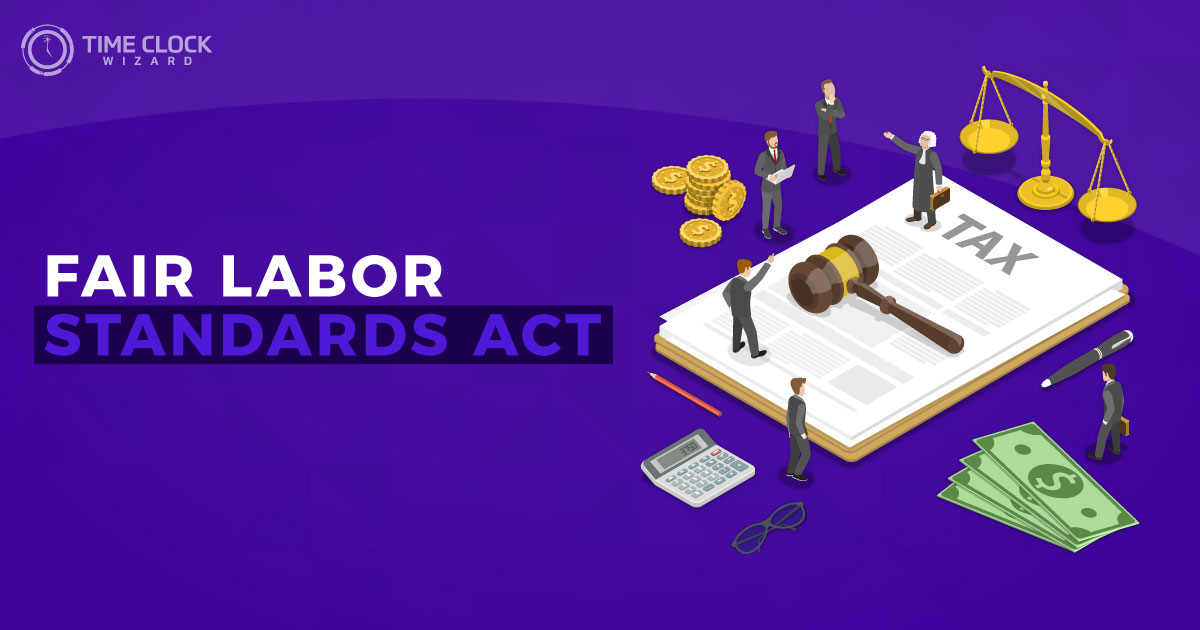
For most companies, computing overtime pay is just part of doing business. You might not want the added expense, but there are times when it’s impossible to avoid it. And when employees do end up working over, you’re obligated to pay them properly. You’ll also want to calculate these extra wages correctly the first time around, as a failure to do so often results in lost time and unnecessary frustration. Worse still, repeated failures to pay overtime correctly can eventually lead to fines and criminal prosecution.
In the following sections, you’ll learn everything you need to know about computing overtime properly.
Employment and Labor Law
There are a number of federal laws governing labor practices in the United States. These laws are enforced by the Department of Labor (DOL), and they apply to all the employees likely to work for you. Understanding these laws will be of great benefit groups of people:
- Human resources departments
- Company management teams
- Employees
- People currently seeking employment
- Retirees
- Contractors and subcontractors
In short, the laws established by the Department of Labor are of great importance to everyone involved in today’s workforce. This certainly includes computing overtime pay, a topic we’ll be focusing on in just a bit. Before we get to that, let’s have a look at some of the overarching laws that regulate employee compensation.
Fair Labor Standards Act (FLSA)
The first thing HR departments and managers need to understand is the Fair Labor Standards Act, more commonly known as the FLSA. The FLSA was first passed in 1938. It was enacted to establish and protect workers’ rights and has been modified many times since its ratification. As an employer, you are required to follow the regulations set out by the FLSA. In order to do this, you have to understand the FLSA and keep up to date on the changes it undergoes over time.
We’ll start with a few of the FLSA’s most basic functions. Some of the FLSA’s employer requirements are fairly complex, but a grasp of the essentials will go a long way toward ensuring you stay compliant. Once you understand these, computing overtime will that much easier. This will help you avoid fines, keep your employees happy, and maintain the stellar reputation you’ve worked so hard to achieve.
FLSA Basics
The FLSA presides over many different areas of employee rights. These include rules for interstate commerce and minimum wage, as well as restrictions on child labor. Most importantly for our purposes, the FLSA also has rules that govern overtime pay. However, there are some notable exceptions. We’ll cover these in the next two sections.
Exempt vs. Non-Exempt Employees
In terms of overtime pay, the Fair Labor Standards Act divides employees into two different categories: exempt and non-exempt. Just as the phrase implies, employees in the exempt category are not entitled to extra overtime pay under FLSA rules. Other federal agents usually cover exempt employees, but FLSA rules cover the majority of American workers. These employees fall into the non-exempt category and are entitled to overtime pay at an increased rate.
The difference between these two types of workers seems complicated at first. Fortunately, there’s a short version. Most employees are non-exempt and entitled to the overtime pay that FLSA regulations stipulate. For extra help with the distinction between exempt and non-exempt employees, use the following guidelines:
- Employees who work in outside sales are FLSA exempt, while inside sales employees are non-exempt.
- The status of most employees depends on how much money they earn, the way they’re paid, and the type of work they do.
- Usually, an exempt employee must make more than $23,600 a year and receive their pay on a salary basis.
- In addition, an exempt employee has to work a job whose duties are exempt.
- Exempt jobs are upper-level positions that involve executive, professional, and administrative duties.
- To qualify as exempt, an employee must satisfy all three of the above criteria.
- The FLSA requires employers to pay non-exempt employees time and a half for each hour of overtime they work.
Again, if your company is like most, the great majority of your employees are non-exempt. For more detailed information, consult the U.S. Department of Labor Website. Next, we’ll have a look at closer look at the FLSA overtime regulations.
FLSA Overtime Regulations
Here’s a summary of the FLSA overtime rules:
- All covered employees must be paid at least 1.5 times their regular rate if they work over 40 hours in a given workweek
- The FLSA does not limit how many hours employees over 16 years can work.
- Unless employees go into overtime on these days, employers are not required to pay a higher rate on weekends or holidays.
- For FSLA purposes, the workweek is a made of seven straight 24-hour periods and doesn’t have to run parallel with the calendar week.
- The workweek can begin on any day of the week and at any time of day.
- Employers may establish different workweeks for different groups of employees, but the same rules apply to all of them.
- Overtime pay is based on hours within a single week. This means employers cannot take the average hours of two or more weeks.
- Employers must pay for overtime hours on the payday that covers the period when the hours were worked.
It is imperative that HR personnel and management teams understand these rules and apply them across the board. You should make sure your employees understand them as well. It’s also a good idea to let them know exactly when your workweek begins and ends. This will help prevent confusion, employee frustration, and unnecessary disputes.
As you can see, these rules mean that tracking employee hours and computing overtime pay accurately should be two of your top priorities. High-quality time tracking software can keep track of employee hours very effectively, but calculating overtime pay merits another discussion.
Computing Overtime Pay Correctly
Calculating an employee’s overtime pay isn’t particularly difficult, but it does require some focused attention. As you’ve already seen, overtime occurs when an employee works more than 40 hours in a given workweek. We’ve also mentioned that the FLSA stipulates that employers must pay at least 1.5 times their regular rate once they exceed 40 hours. Many companies opt to pay more than 1.5 times the regular rate, but the following remarks will assume you’re paying the minimum.
The typical overtime scenario is pretty simple. Let’s say an employee’s regular rate is $17 an hour. If they work exactly forty hours in a given week, this employee’s gross wages would total $680. But let’s say the employee works 46.5 hours during a moderately busy week. To arrive at the overtime rate, you simply multiply $17 x 1.5 and arrive at a total of $25.50/hour. The rest of the calculation would run as follows:
- The regular pay rate of $17/hour x 40 hours = $680
- The overtime rate of $25.50/hour x 6.5 hours = $165.75 in overtime pay
- The regular pay of $680 + $165.75 in overtime pay = $845.75
This is a fairly straightforward example, but overtime pay can be much more complicated at times. Fortunately, there’s help out there. The Department of Labor offers an excellent FLSA Calculator tutorial on its website and a simple internet search will direct you to an easy-to-use overtime hours calculator.
Complying with The Equal Pay Act
Another important factor in employee compensation is the Equal Pay Act of 1963. An extension of the FLSA, the Equal Pay Act (EPA) was enacted to eliminate wage disparities based upon gender. Essentially, the EPA requires employers to pay equal pay for equal work regardless of an employee’s gender. The EPA was a landmark moment in the fight against sexual discrimination and remains as important today as it was when Congress first passed it.
As anyone who’s paying attention already knows, the gender pay gap is a hot-button issue in both the workplace and our culture as a whole. But it’s especially important to HR departments and something you should pay constant attention to. Otherwise, your company will be open to lawsuits, fines, and a damaged reputation that can be very difficult to repair. And while the concept of equal pay for equal work might seem simple on the surface, the EPA is actually more complicated than it looks.
That’s why it’s so important to familiarize yourself with the details of the Equal Pay Act and stay abreast of any changes.
Staying Up To Date on FLSA Changes
The rules and regulations of the Fair Labor Standards Act have changed significantly over the years. A quick look at the recent history of the FSLA will show you why you have to stay up to date on the federal overtime standards at all times.
The FLSA experienced sweeping changes during the Obama administration. Among other things, 4 million additional workers became eligible for FLSA mandated overtime pay. But a federal judge struck these changes down in August 2017, and these 4 million employees were no longer eligible for mandatory overtime pay. The Department of Labor eventually appealed the injunction, but they requested that appeal be delayed until it could formulate a new proposal.
Unfortunately, we’re still waiting for the Department of Labor to present its proposal regarding FLSA overtime eligibility. After a long delay, the DOL promised to unveil their proposal in January 2019. But the proposal was again postponed, and employers now have to wait until March 2019 for the DOL’s response.
You can find a detailed list of FLSA 2018 changes by clicking here, but you can see from the scenario we just described how complicated things can get. Of course, this doesn’t change the fact that you’re responsible for staying compliant with any changes that do occur.
Conclusion
Typically, companies do everything they can to avoid letting employees go into overtime. But as you probably know from experience, it’s often necessary for key employees to work more than 40 hours a week. This is especially true during your industry’s busy season and when your company undergoes significant changes. There are also times when paying a reasonable amount of overtime is cheaper than hiring and training new employees.
In the end, the reasons for overtime pay don’t really matter. In fact, the only that does matter is that you handle overtime pay properly. When a business fails to adhere to overtime laws, the results can be costly in more ways than one. Fortunately, you have a solution. By following the guidelines we’ve discussed here, you’ll be able to handle overtime pay with relative ease.







